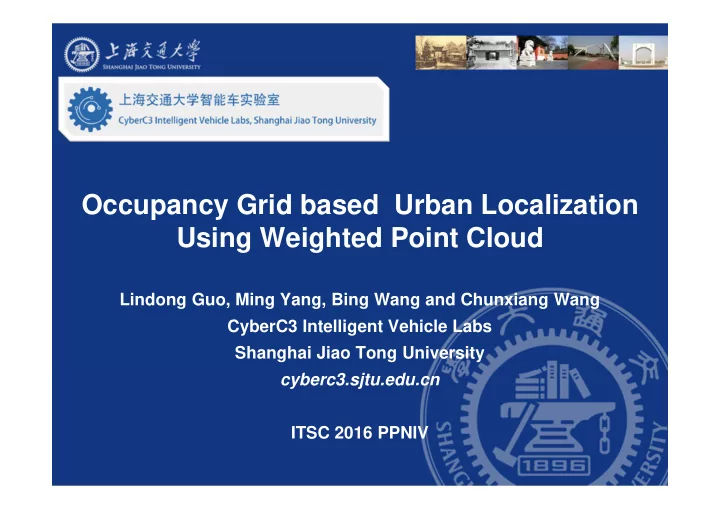

Occupancy Grid based Urban Localization Using Weighted Point Cloud Lindong Guo, Ming Yang, Bing Wang and Chunxiang Wang CyberC3 Intelligent Vehicle Labs Shanghai Jiao Tong University cyberc3.sjtu.edu.cn ITSC 2016 PPNIV
Contents Motivation & Our goal System architecture Sensor data process • Weighted point cloud • Occupancy grid generation Localization Experiments Conclusion
Motivation Localization • Without map • GNSS based methods • SLAM based methods • Using prebuilt map • Accuracy • Cost Environment • Urban , structured • Relatively large scale
Our goal Suitable map representation • 2D/2.5D representation • Light and flexible Reasonable sensor configuration • Relatively low-cost • General or universal Light localization method • Matching with generated map, not raw data
System architecture
Weighted point cloud Weighting • Ring Compression Analysis based curb detection method [A. Y. Hata , IV2014] • Based on plane model • curbs • building facades • Useful features Featured point cloud extraction Point cloud weighting
Weighted point cloud Example of weighted point cloud • Filter • Road surface • Disadvantages • rise and fall of roads • Moving objects • Other disturbs • Need further filtering
Occupancy grid map generation Properties for each grid • Height gap • Points account • Points weight • Function
Localization Pose initialization • Gps added • Pyramid map matching Localization with maximum likelihood matching
Experimental results Testing platform • CyberTiggo • VLP-16 or LMS-151 on top • Odometer 3D • Core-i7 @2.6GHz 2D
Experimental results Experimental fields • Long distance • 2 scenes
Experimental results II I Results
Vehicle with single layer laser scanner demo Vehicle with 3D lidar Robot with hokuyo
Conclusion Conclusion • Relatively accurate (but not enough) • Light weight • Adaptive approach • Testing and working on products Future work • Extend the method, make it general • Combine with SLAM • Moving objects while mapping and localization • more…
Thank You
Recommend
More recommend